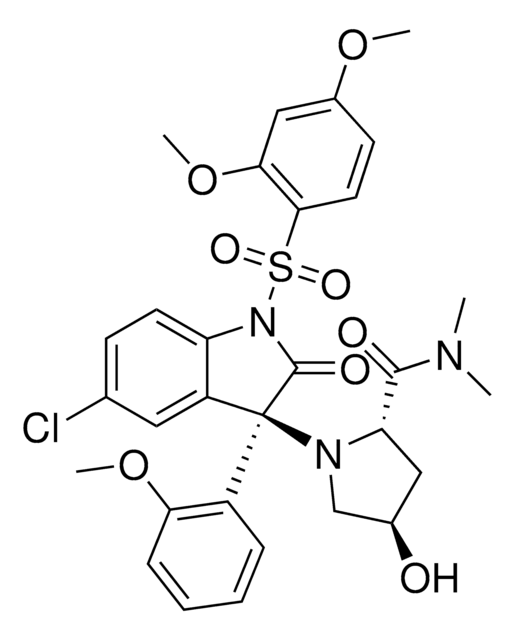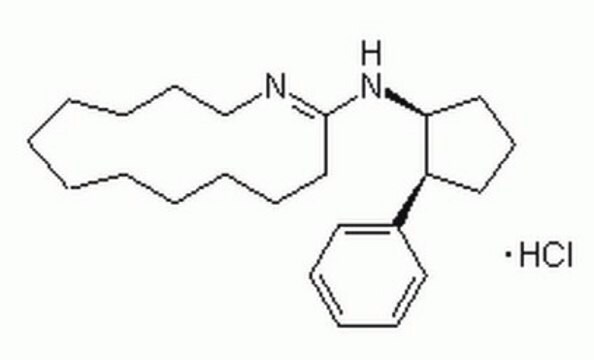V1880
[deamino-Pen1, O-Me-Tyr2, Arg8]-Vasopressin
≥97% (HPLC)
About This Item
Produits recommandés
Stérilité
non-sterile
Essai
≥97% (HPLC)
Forme
powder
Solubilité
water: 0.5 mg/mL, clear, colorless
Conditions d'expédition
ambient
Température de stockage
−20°C
Chaîne SMILES
COc1ccc(CC2NC(=O)CC(C)(C)SSCC(NC(=O)C(CC(N)=O)NC(=O)C(CCC(N)=O)NC(=O)C(Cc3ccccc3)NC2=O)C(=O)N4CCCC4C(=O)NC(CCCNC(N)=N)C(=O)NCC(N)=O)cc1
InChI
1S/C49H70N14O12S2/c1-49(2)24-40(67)57-32(22-28-13-15-29(75-3)16-14-28)43(70)60-33(21-27-9-5-4-6-10-27)44(71)58-31(17-18-37(50)64)42(69)61-34(23-38(51)65)45(72)62-35(26-76-77-49)47(74)63-20-8-12-36(63)46(73)59-30(11-7-19-55-48(53)54)41(68)56-25-39(52)66/h4-6,9-10,13-16,30-36H,7-8,11-12,17-26H2,1-3H3,(H2,50,64)(H2,51,65)(H2,52,66)(H,56,68)(H,57,67)(H,58,71)(H,59,73)(H,60,70)(H,61,69)(H,62,72)(H4,53,54,55)
Clé InChI
HNOGCDKPALYUIG-UHFFFAOYSA-N
Informations sur le gène
human ... AVPI1(60370)
mouse ... AVPI1(69534)
rat ... AVPI1(171386) , LOC689723(689723)
Amino Acid Sequence
Application
Actions biochimiques/physiologiques
Notes préparatoires
Mention d'avertissement
Warning
Mentions de danger
Conseils de prudence
Classification des risques
Acute Tox. 4 Inhalation
Code de la classe de stockage
11 - Combustible Solids
Classe de danger pour l'eau (WGK)
WGK 3
Équipement de protection individuelle
dust mask type N95 (US), Eyeshields, Gloves
Faites votre choix parmi les versions les plus récentes :
Déjà en possession de ce produit ?
Retrouvez la documentation relative aux produits que vous avez récemment achetés dans la Bibliothèque de documents.
Active Filters
Notre équipe de scientifiques dispose d'une expérience dans tous les secteurs de la recherche, notamment en sciences de la vie, science des matériaux, synthèse chimique, chromatographie, analyse et dans de nombreux autres domaines..
Contacter notre Service technique
![[Arg8]-Vasopressin acetate salt ≥95% (HPLC)](/deepweb/assets/sigmaaldrich/product/structures/282/717/a4c16d4f-e168-4d84-a0e3-59de3e06251e/640/a4c16d4f-e168-4d84-a0e3-59de3e06251e.png)

![[deamino-Cys1, Val4, D-Arg8]-Vasopressin ≥95%](/deepweb/assets/sigmaaldrich/product/structures/242/492/d66f6a61-e108-4db6-b155-90a4b56d99fc/640/d66f6a61-e108-4db6-b155-90a4b56d99fc.png)





![[deamino-Cys1, D-Arg8]-Vasopressin acetate salt hydrate ≥95% (HPLC)](/deepweb/assets/sigmaaldrich/product/structures/215/222/82da3633-80ea-463d-8b55-e99fb8e442e0/640/82da3633-80ea-463d-8b55-e99fb8e442e0.png)
